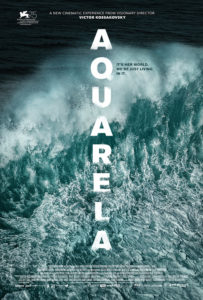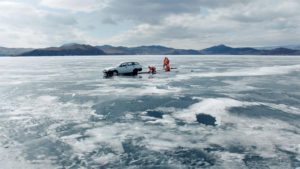Film Review: Visually Stunning “Aquarela” Delivers Soggy Narrative
Written by: Christopher Llewellyn Reed | August 22nd, 2019

Aquarela (Viktor Kossakovsky, 2018) 2½ out of 4 stars.
A frequently beautiful meditation on water in all its forms (ice, snow and pure liquid), the new documentary Aquarela achieves its most spectacular narrative effects when placing people at its center. Unfortunately, all too often the film is a pageant in search of meaning, substituting cinematic splendor for consequential metaphysics. Simultaneously too much and not enough Koyaanisqatsi (the seminal 1982 pan-global extravaganza from Godfrey Reggio), Aquarela can never settle on whether to let nature tells its own tale or to include the human element. Scenes featuring the latter are how it begins, with a fascinating sequence set on Russia’s (almost) frozen Lake Baikal, where local residents drive across the sometimes-thin ice at their peril. This terrific opener sets up certain storytelling expectations that are never met again. Couple that disappointment with an abrasive, over-used heavy-metal score, and the movie is a decidedly uneven experience. But still stunning to look at.
Then again, unevenness perhaps suits a film about undulation. Whether we find ourselves on water or ice, everything moves, on occasion gently but most commonly in crashing blocks of glacial calving or towering storm-churned turbulence. After watching Aquarela what I now really want to see is the behind-the-scenes movie about its making. So much of what is on screen looks terrifying and dangerous that I’d pay big money to learn the risks involved in gathering footage. Much (though not all) of that human drama is left out of what we have here. Director Viktor Kossakovsky (¡Vivan las antípodas!) deserves high praise, however, for the austere majesty of his compositions (shot at 96 frames per second, rather than the usual 24), whether they be of the sea roiling in visceral proximity or the icebergs falling from above (or shot from below), the power of nature always close at hand.

Would that these images, plagued by a jarring score (from Apocalyptica’s Eicca Toppinen) added up to significantly more than the sum of their moving parts. Much of them compel, all the same, as we travel from Baikal to Greenland to Miami to Venezuela, ending on that last country’s Angel Falls (the highest waterfall in the world). Kossakovsky and his crew excel at the visual study of water and its direct effects on immediate surroundings. If one day we destroy ourselves, leaving behind a warmer planet covered by greater oceans, I am sure the remaining H2O molecules will hold up Kossakovsky’s documentary as a model representation of what they can achieve. For mere human viewers, though, who might seek some contextualization of the elliptically embroidered shots, the filmic force is mitigated by the prioritizing of style over content, and the refusal to commit fully to the experiment of form. Those structural issues notwithstanding, Aquarela is nevertheless breathtaking to behold.


